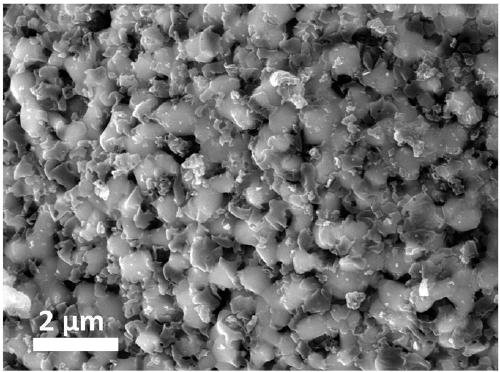Transition metal phosphide hydrogen-evolution composite material as well as preparation method and application thereof
A transition metal and composite material technology, applied in chemical instruments and methods, physical/chemical process catalysts, electrolysis processes, etc., can solve the problems of complex transition metal phosphide methods, large consumption, dangerous operation, etc. The effect of large-scale production, improved application value and low price
- Summary
- Abstract
- Description
- Claims
- Application Information
AI Technical Summary
Problems solved by technology
Method used
Image
Examples
Embodiment 1
[0063] Step (1): Synthesis of polyvinylphosphonic acid: Polyvinylphosphonic acid was synthesized according to the method reported by Millaruelo et al. Weigh 5g of vinylphosphonic acid monomer and 0.15g of azobisisobutyronitrile into a 100ml round bottom flask, then add 28ml of ethyl acetate as a solvent into the flask, cover with a rubber stopper, and quickly place the system in liquid nitrogen , the reaction system was evacuated under the condition of liquid nitrogen freezing, the temperature was raised to room temperature and filled with dry nitrogen, and after repeated operations for 3-5, the temperature of the reaction system was raised to 60° C. for 6 hours of reaction. After the reaction, the reaction solvent was spin-dried, and then an appropriate amount of water was added to dissolve the sample, and then dialyzed in water, changing the water every 2 hours, dialyzed for two days, and freeze-dried to obtain polyvinylphosphonic acid (white solid).
[0064] Step (2): Prepa...
Embodiment 2
[0071] Compared with Example 1, the only difference is that in step (2), the transition metal salt is copper nitrate trihydrate, and the dosage is 1.18g (P / Cu element molar ratio is 1:1). The dual network hydrogel diagram is shown in figure 1 . After calcining in the step (3), the copper phosphide / carbon in-situ composite material is obtained. The obtained Co 2 The morphology of P hydrogen evolution composites is not a carbon framework structure. The XRD spectrum pattern of the product that this case obtains is attached figure 2 As shown, by comparing with the standard map, it shows that Cu was successfully prepared 3 p. When the current density is 10mAcm -2 , the material has an overpotential of 512mV and a Tafel slope of 220mV dec -1 .
Embodiment 3
[0073] Compared with Example 1, the only difference is that in step (2), the transition metal salt is nickel chloride hexahydrate, and the dosage is 1.09g (P / Ni element molar ratio is 1:1). The dual network hydrogel diagram is shown in figure 1 . After calcining in the step (3), the nickel phosphide / carbon in-situ composite material is obtained. The obtained Co 2 The morphology of P hydrogen evolution composites is not a carbon framework structure. The XRD spectrum pattern of the product that this case obtains is attached figure 2 As shown, the overpotential of the material is 336mV, and the Tafel slope is 122mV dec -1 .
PUM
 Login to View More
Login to View More Abstract
Description
Claims
Application Information
 Login to View More
Login to View More - R&D
- Intellectual Property
- Life Sciences
- Materials
- Tech Scout
- Unparalleled Data Quality
- Higher Quality Content
- 60% Fewer Hallucinations
Browse by: Latest US Patents, China's latest patents, Technical Efficacy Thesaurus, Application Domain, Technology Topic, Popular Technical Reports.
© 2025 PatSnap. All rights reserved.Legal|Privacy policy|Modern Slavery Act Transparency Statement|Sitemap|About US| Contact US: help@patsnap.com



